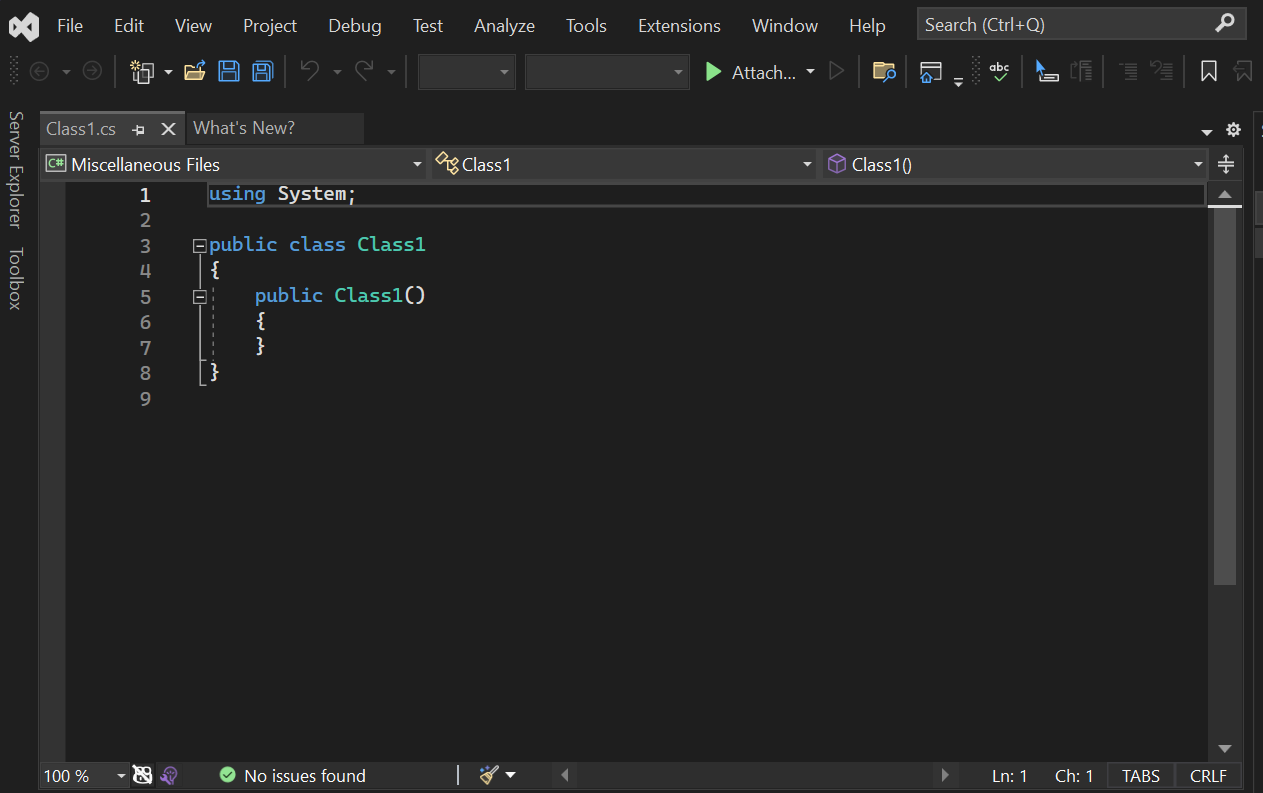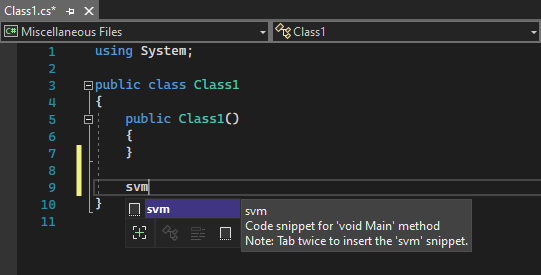Note
Access to this page requires authorization. You can try signing in or changing directories.
Access to this page requires authorization. You can try changing directories.
In this introduction to the Visual Studio code editor, you’ll add code to a file and explore how Visual Studio helps make writing, navigating, and understanding code easier.
If you haven't already installed Visual Studio, go to the Visual Studio downloads page to install it for free.
This article assumes you're already familiar with a programming language. If you aren't, we suggest you look at one of the programming quickstarts first, such as create a web app with Python or C#, or create a console app with Visual Basic or C++.
Prerequisites
- Visual Studio with C# development settings configured. To configure settings, see Select environment settings.
Create a new code file
Create a new file and add some code to it.
Open Visual Studio. Select the Esc key, or select Continue without code on the start window, to open the development environment.
From the File menu on the menu bar, select New > File, or select the Ctrl+N keys.
In the New File dialog box, under the General category, select C# Class, and then select Open.
A new file opens in the editor with a basic C# class structure.

Use GitHub Copilot
GitHub Copilot acts as an AI pair programmer to provide autocomplete-style code completions and context-aware multi-line code suggestions, as you code, in real-time, right in the editor. GitHub Copilot turns natural language prompts including comments and method names into coding suggestions. You can view and incorporate suggestions from GitHub Copilot directly within the editor.
Let's use Copilot to generate code suggestions:
Place your cursor just below the final closing brace } in the file.
Type a natural language comment:
// Add a method to add two numbersand Enter.GitHub Copilot generates a code suggestion for you. The suggested implementation shows in gray text.
To accept the suggestion, select Tab.
Let's use Copilot Chat to submit a coding-related question as a prompt:
Select the GitHub Copilot badge in the upper-right corner of the IDE.
Select Open Chat Window from the dropdown.
Enter the following prompt in the chat window:
Generate sample code for a simple C# method to add two numbers.Copilot Chat generates sample code in response to your prompt.
GitHub Copilot is powered by AI, so surprises and mistakes are possible. For more information, see GitHub Copilot FAQs.
Get started with GitHub Copilot in Visual Studio.
Use code snippets
Visual Studio provides useful code snippets that you can use to quickly generate commonly used code blocks. Code snippets are available for several programming languages, including C#, Visual Basic, and C++.
Now add the C# void Main snippet to your file.
Place your cursor just above the final closing brace
}in the file, and type the characterssvm.A pop-up dialog box appears with information about the
svmcode snippet.
Select the Tab key twice to insert the code snippet.
You'll see the
static void Main()method signature get added to the file. The Main() method is the entry point for C# applications.
Available code snippets vary by programming language. To view the available code snippets for your language, go to Edit > IntelliSense > Insert Snippet or select Ctrl+K, Ctrl+X keys, then select the folder for your programming language. For C#, the code snippet list looks like this:

The list includes snippets for creating a class, a constructor, a for loop, an if or switch statement, and more.
Comment out code
The Text Editor toolbar, the row of buttons under the menu bar in Visual Studio, helps make you more productive as you code. For example, you can toggle IntelliSense completion mode, increase or decrease a line indent, or comment out code you don't want to compile.

Let's comment out some code.
Paste the following code into the
Main()method body.// someWords is a string array. string[] someWords = { "the", "quick", "brown", "fox", "jumps" }; string[] moreWords = { "over", "the", "lazy", "dog" }; // Alphabetically sort the words. IEnumerable<string> query = from word in someWords orderby word select word;The
moreWordsvariable isn't currently being used, but you might use it later, so instead of deleting it, you can comment out those lines. Select the entire definition ofmoreWordsdown to the closing semicolon, and then select the Comment out the selected lines button on the Text Editor toolbar, or select Ctrl+K, Ctrl+C.
The C# comment characters
//are added to the beginning of each selected line to comment out the code.To uncomment lines, you can select them, and then select Uncomment the selected lines button on the Text Editor toolbar, or select Ctrl+K, Ctrl+U.

Collapse code blocks
If you don't want to see the empty constructor that was generated for Class1, you can collapse it to unclutter your view of the code. Select the caret sign in the margin of the first line of the constructor. Or, if you prefer to use the keyboard, place the cursor anywhere in the constructor code and select the Ctrl+M, Ctrl+M keys.

The code block collapses to just the first line, followed by an ellipsis (...). To expand the code block again, select the caret sign (>), or select Ctrl+M, Ctrl+M again. This feature is called Outlining and is especially useful when you're collapsing long methods or entire classes.
View symbol definitions
The Visual Studio editor makes it easy to inspect the definition of a type, method, or variable. One way is to go to the definition, in whichever file has it, by choosing Go to Definition or by selecting the F12 key anywhere a symbol is referenced. An even quicker way that doesn't move your focus away from the code you're working on is to use Peek Definition.
Let's peek at the definition of the string type.
Right-click on any occurrence of
stringand choose Peek Definition from the content menu. Or, select the Alt+F12 keys.A pop-up window appears with the definition of the
Stringclass. You can scroll within the pop-up window, or even peek at the definition of another type from the peeked code.
Close the peek definition window by choosing the small box with an "x" at the top right of the pop-up window.
Use IntelliSense to complete words
IntelliSense is an invaluable resource when you're coding. It can show you information about available members of a type, or parameter details for different overloads of a method. You can also use IntelliSense to complete a word after you type enough characters to disambiguate it.
Let's add a line of code to print out the ordered strings to the console window, which is the standard place for output from the program to go.
Below the
queryvariable, start typing the following code:foreach (string str in quYou'll see an IntelliSense pop-up appear with information about the
querysymbol.
If you're signed in with a GitHub account that has a Copilot subscription, you'll also see code suggestions appear in gray text.
To insert the rest of the word
queryby using IntelliSense word completion, select the Tab key.Finish off the code block to look like the following code. You can practice further with code snippets by entering
cwand then selecting Tab twice to generate theConsole.WriteLinestatement.foreach (string str in query) { Console.WriteLine(str); }
Refactor a name
Nobody gets code right the first time, and one of the things you might have to change is the name of a variable or method. Let's try out Visual Studio's refactor functionality to rename the someWords variable to unsortedWords.
Place your cursor over the definition of the
someWordsvariable, and choose Rename from the right-click or context menu, or select the F2 key.A Rename dialog box appears at the top right of the editor.

Enter the desired name unsortedWords. You'll see that the reference to
unsortedWordsin thequeryassignment statement is also automatically renamed. Before you select the Enter key, select the Include comments checkbox in the Rename pop-up box.
Select the Enter key.
Both occurrences of
someWordsin your code have been renamed, as well as the textsomeWordsin your code comment.
